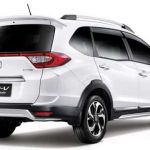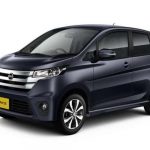Contents
- 1 Engine
- 2 Engine displacement
- 3 Power
- 4 Transmission
- 5 Cylinders
- 6 Cylinder Configuration
- 7 Compression Ratio
- 8 Fuel
- 9 Valves per Cylinder
- 10 Valve Mechanism
- 11 Drivetrain
- 12 Overall Length
- 13 Overall Width
- 14 Overall Height
- 15 Wheel Base
- 16 Ground Clearance
- 17 Boot Space
- 18 Kerb Weight
- 19 Suspension
- 20 Multi-Link Suspension
- 21 Shock Absorber
- 22 Brakes
- 23 Wheel Type
- 24 Wheel Size
- 25 Airbags
- 26 Seat belts
- 27 Child Lock
- 28 Immobilizer
- 29 ISOFIX Child Seat Anchors
- 30 Vehicle Stability Control
- 31 Traction Control
- 32 Hill Start Assist Control
Engine
The engine or motor is a device that converts one or more forms of energy into mechanical energy.
This process is initiated by a spark, which ignites a mixture of petrol vapour and compressed air inside a momentarily sealed cylinder, causing it to burn rapidly. This is the reason why the machine is referred to as an internal combustion engine. As the mixture burns, it expands, providing power for the automobile.
Reference: howacarworks
Engine displacement
An engine’s displacement is defined as the area swept by all of the pistons of the engine, excluding the combustion chambers. It is commonly used as an indication of the size of an engine, and by extension the amount of power and fuel, it is capable of producing. It is described by terms such as 250 cubic centimeters, 5.7 liters, or 426 cubic inches how much air an engine can move. These are just different ways of describing the same thing: displacement.
Power
Engine power refers to the amount of power that an engine can produce. In most cases, it is expressed in kilowatts, pferdestärkes (metric horsepower), or horsepower.
Torque
The torque, on the other hand, is an expression of a rotational or twisting force. In vehicles, the engines rotate around an axis, which produces torque. The torque of a vehicle can be viewed as its “strength.” The torque is what propels a sports car from 0-60 in seconds and pushes you backward. A large truck hauling heavy loads is also powered by it.
Transmission
The gearbox has a number of selectable ratios and is used to match the engine’s torque and rpm to the demands of the vehicle.
Cylinders
It is the unit of an engine that burns fuel, which is then converted into mechanical energy that gives power to the vehicle after it has been burned. In most cases, cylinders are equipped with pistons, which move up and down to generate kinetic energy.
Cylinder Configuration
Engines have cylinders arranged in a line, and most have a V-shape. Cylinders are arranged in two banks on opposite sides of the engine
Compression Ratio
When the piston is at the bottom of its stroke, the volume of the combined cylinder and combustion chamber is the same as when the piston is at the top of its stroke. The higher the compression ratio, the more mechanical energy an engine can extract from its air-fuel mixture.
Fuel
Vehicles are equipped with fuel tanks that are filled with fuel. Each vehicle has a different capacity for its fuel tank. Small vehicles have a smaller fuel tank capacity while large vehicles have a larger tank capacity.
Valves per Cylinder
The number of valves per cylinder refers to how many valves are present in each cylinder of the engine, for example, two valves, three valves, four valves, five valves, and even six valves. The more valves there are, the better the efficiency of the intake and exhaust systems.
A four-stroke internal combustion engine has almost two valves per cylinder. The first is for the intake of air and fuel, and the second is for the exhaustion of combustion gases.
Valve Mechanism
A valve mechanism defines the sequence in which a valve opens and closes. It performs the opening of the cylinders to the intake or exhaust manifold at the appropriate time.
Drivetrain
All components of a car that produce power and transmit it to the wheels, including the engine, transmission, differential(s), hubs, and any shafts that connect them.
Overall Length
A vehicle’s length is measured from the rear bumper to the front bumper. It is measured in mm or feet.
Overall Width
The width of a car is measured from the front or rear side to the other side, and it is expressed in feet or millimeters.
Overall Height
The height of the vehicle is measured from the ground to the top of the roof and is expressed in feet or millimeters
Wheel Base
Wheelbase refers to the distance between the centers of the front and rear wheels of a vehicle. A vehicle’s wheelbase is relatively shorter than its overall length.
Ground Clearance
Ground clearance refers to the distance between the vehicle’s underside and the ground. The distance indicates how high the lowest part of the vehicle is from the road. The ground clearance does not include the tire, wheel hub, brake backing plate, mudflap, or flexible mudguard.
Boot Space
In a car, it is a space for storing luggage and is generally located at the rear. Hatchback cars usually have it behind the rear seat; large cars have it in a separate place and it is measured in liters, such as 400 liters of boot space.
Kerb Weight
A vehicle’s dry weight is its weight without oil, coolant, fuel, and sometimes even without the battery and brake fluid.
Suspension
A suspension system is made up of tires, tire air, springs, shock absorbers, and linkages connecting the wheels to the vehicle and allowing relative movement between them. The suspension maintains the same motion of two tires and allows them to move at the same speed even when moving on uneven roads.
Multi-Link Suspension
As this suspension has four arms or links, but no struts, it provides a better ride and handling for the vehicle.
A multi-link suspension allows the vehicle to bend more; this means that it can adjust more easily to the varying angles encountered in off-road driving. A multi-link-equipped vehicle is ideal for desert racing.
Shock Absorber
A shock absorber is a suspension component that controls the up and down motion of the wheels of the vehicle. As a result of shocks, excessive motion is dampened and the vehicle’s body bounces down the road. The bounce test is an established method of testing shock absorber health, but mechanics claim it prevents oil leakage.
Brakes
To slow down or stop a moving vehicle, you must apply the brakes. The brakes are responsible for creating friction between two surfaces. Different types of brakes are available, but the purpose of each is to stop or slow moving objects.
Wheel Type
In simple terms, a wheel is an object that revolves on an axle and is fixed under the vehicle. This wheel can move easily and it will be able to carry heavy loads from one place to another.
Wheel Size
The size of the wheels varies depending on the vehicle’s body. There are two types of wheels: small wheels and large wheels. Small wheels are used for cars and other small vehicles, while large tires are used for large and heavy vehicles which have the ability to carry heavy loads.
Airbags
If a major impact or collision with another vehicle occurs, the passengers may encounter interior frame, siding, and other areas and may sustain injuries. In order to prevent such an untoward event, these cushions are filled with air, reducing the likelihood of a collision and protecting the passenger from any possible harm.
Seat belts
Seat belts reduce the likelihood of death or serious injury in a traffic collision by reducing secondary impacts with interior strike hazards, keeping occupants positioned appropriately for maximum airbag effectiveness, and preventing them from being ejected from the vehicle in the event of a crash.
Child Lock
You may open the car’s rear door and look for a lever, switch, or twist lock at the vehicle’s side. When enabled, the kid lock stops the back seat occupants from opening the door from the inside.
Immobilizer
An immobilizer, is an electronic security mechanism installed on a car that stops the engine from starting unless the right key is present. This prevents the car from being “hot wired” when access is gained, reducing motor vehicle theft.
ISOFIX Child Seat Anchors
ISOFIX is the worldwide standard for child safety seat attaching points in passenger vehicles. In addition to LATCH (“Lower Anchors and Tethers for Children”) in the United States, the system is also known as LUAS (“Lower Universal Anchorage System”) or Canfix in Canada. [1] It has also been known as the UCSSS or “Universal Child Safety Seat System.”
Vehicle Stability Control
Vehicle Stability Control utilises the vehicle’s brakes to aid in steering during instances of sliding or potential spinout. Individual wheel braking is used to combat oversteer and understeer. During these actions, the majority of VSC systems automatically cut engine power to further increase traction. Toyota’s systems are designated VSC or Vehicle Dynamics Integrated Management (VDIM)
Traction Control
It is the electronic control system that avoids wheelspin by recognising when the driving wheel is about to lose traction and reducing engine power or applying the appropriate brakes to prevent the wheel from breaking..
Hill Start Assist Control
Hill assist is a function that is engaged automatically when you apply and release the brakes on a hill while keeping brake pressure to prevent your vehicle from rolling back.
Kamran Hussain is a motorcycle enthusiast and expert with over 5 years of experience in the industry. As a seasoned rider, he has a deep understanding of the motorcycle market and is dedicated to helping riders find the best bikes and gear to suit their needs.
Kamran Hussain has written extensively on motorcycle topics, including buying guides, product reviews, and maintenance tips. With his comprehensive knowledge of the industry, he is a trusted source for motorcycle enthusiasts seeking reliable information and advice.






